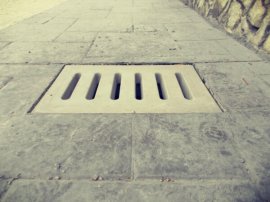
With increasing urbanization and the pressure of population, the impervious surfaces in the metros are increasing, thereby increasing the volume of storm water runoff. As a result, drainage managers face additional wastewater from the highly populated areas for which the existing drains are totally inadequate. In almost all of India’s cities, drainage has lagged behind water supply development and has neither been planned nor implemented fully in a majority of the cases. The new housing estates receive water supply through pipelines or tankers, these localities do not even have a well-defined sewerage system and it is a common sight in most cities to see raw sewage flowing into the open storm drain.
One of the main hurdles to the proper management of the drainage system in a majority of the cities is the management and the quality. A good drainage system includes all the components needed to ensure that the substructure is properly drained, and may be formed of components such as open ditches, closed ditches with pipe drains and drainage through stormwater drainage pipes, channels and culverts. Where there are changes in the terrain or water flow, the drainage system is planned with particular care. Overloading can result in major damage in the form of erosion and landslides. One of the drainage system’s functions is to collect surface water and/or ground water and direct it away, thereby keeping the ballast bed drained. The drainage system must also protect the substructure from erosion, from becoming sodden, and from losing its load-bearing capacity and stability.
Concrete is an ideal choice for durable drainage system. In every region across the country, engineers, transportation departments and contractors know they can trust concrete pipe as the most resilient choice to last for over 100 years. This has given us the evidence of what has worked and what has not worked so well so that, over time, it is possible to eliminate problems and achieve higher and higher performance levels. These concrete pipes let water enter through holes or slits in the pipe wall or through open joints. They have sufficient mechanical strength to tolerate design loads from traffic and soil, as well as being capable of resisting local climate and environmental stresses. The pipes are laid without rubber packing washers, allowing drainage to occur through open joints. During this process, sufficient room for the sockets must be excavated, ensuring that the body of the pipe lies evenly against the foundation.
With concrete pipe, durability deals with the life expectancy and enduring characteristics of its materials. The longevity of concrete and the inherent robustness has become an increasingly attractive characteristic. It’s long-term performance is proven and it’s innovation has made it more reliable and dependable than ever. This innovation includes improvements to concrete mixes, pipe design and manufacturing processes. Concrete pipes are designed to efficiently convey the fluid. Secondly, they are structures, and support the weight of the earth, as well as live loads above it. Unlike alternate products, concrete pipe accomplishes both functions through its inherent strength and rigidity. The rigid quality of concrete provides both structure and conduit when it arrives on site. In addition to this, it’s capability to perform as expected for the design life of a project is a fundamental engineering consideration, especially in today’s economic environment, where requirements have been set in place to ensure a sustainable buried infrastructure.
